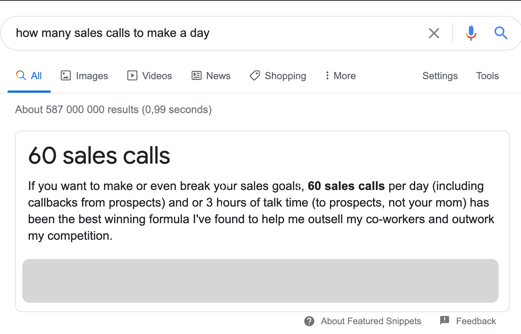
If you Googled that headline, most probably you’ll land on some page or article giving you the 60 or 100 dials per day mantra.

While it's sweet to have the exact figure delivered to your door, most sales managers/ sales reps struggle to find out the exact number that works for them.
Typically, first calls (when your aim is to just get a 2nd meeting) can be shorter. On the other hand, if you are deeper in the sales funnel and doing a sales pitch, you’ll have to reserve a longer time per call.
Here at Salestrail, we absolutely love sales call stats (after all, that’s our bread and butter!). However, our scepticism antennas always go up when we sniff an illogical fact –- it goes against our no-BS rule!
So, when such “100 calls per days facts” showed up on our screens, we did what we do the best –– we decided to hammer some logic into that statement.
Hint: Your average number of sales calls per day depends on your personal quota and the nature of your sales calls.
In this article:
The aim of making calls is not logging a certain number each day but to reach a certain goal. And the goal depends on your job profile. For instance, cold callers need to get the next meeting while sales reps call to qualify warm leads.
It is your goals/targets that sets how many calls you really need to make per day.
Let’s do some quick math based on some well-known industry facts:
Those are just industry averages.
What works best for you can only be determined by checking your own call performance. Only then can you get a true picture of your conversion rate and average contact attempts.
(Psssst...Don’t know how to pull those stats out of your hat? Just download Salestrail on your mobile phone and choose to load call history. Then, sit back, relax and let the Salestrail dashboard crunch the data! )
Now that you have your own stats in hand, based on your role and targets, do the reverse calculation (we've covered reverse-engineering in sales in great detail here).
So, for example, if you are a cold caller with a weekly target of 50 leads –– you need to make at least 300 (6 calls x 50 leads) calls per week to reach your target. That is an average of 60 cold calls per working day.
Similarly, if you are a sales rep who needs to get 10 qualified opportunities per week –– you need to make roughly 180 calls (18 attempts x 10 prospects). That means an average of 36 sales calls per working day.
Knowing how many calls per day you can make won’t suffice to reach your real goals.
You need to have a daily game plan.
To give you an example, not all days are the same.
Surveys say Tuesdays, Wednesdays and Thursdays generate the best results. We also know that the best times to call customers is between 10 to 11 a.m in the morning. Another good slot is between 4 p.m. to 5 p.m.
Knowing this, you should not be evenly distributing your call targets throughout the workweek or workday. It would be wiser to bunch the majority of your calls around these three days.
Apply the 80/20 rule here spend more resources on the "20% of the times/days" when people pick up more and try to make the most of it.
Also, make the first-touch calls earlier during the day. This way, you’ll have a decent follow-up pipeline for the evening –– when people don’t mind slightly longer chats as they wrap up for the day.
The worst times and days for calling –– like Fridays –– can be a good window to, say, researching your prospects.
It’s not just about quantity, quality matters too. So, you may make a 100 dials a day - but it won’t matter if you aren’t doing the right things during those calls. Take for instance:
As you probably can see, monitoring your own call analytics can give you more benefits than you thought.
Unless you track your own data, you can never know what you are doing right, what’s working for your clientele and where you’re going wrong and there’s room for improvement.
For instance, with Salestrail’s call analytics dashboard, you can get detailed insights like:
With such stats, it becomes much easier to set optimal weekly targets as well as optimise the conversion and closing cycles.
Get a free trial: Liked what you read above? Get in touch and we’ll show you even more customised ways to optimise your sales process.
Get sales resources: Head to the Salestrail blogs for such in-depth guides, free templates, researched articles on sales calling. Also, subscribe to our newsletter for sales tips and resources delivered right to your inbox.
Share (to show you care!): Found this article interesting? Why not share it with your team? Just hit the social buttons on the sidebar.
These Stories on Sales Best Practices
Fredrikinkatu 33 A,
00120 Helsinki, Finland
Call :+358 40 768 3813
Email: support@liid.com
No Comments Yet
Let us know what you think